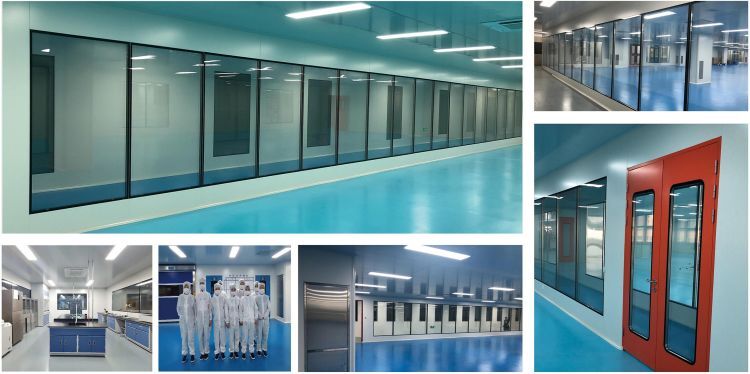
GMP Cleanroom For Medical Devices
Authoritative documents such as ISO 14644 and FS-209E provide no specific instructions regarding activities carried out in medical device environments. Broadly, medical device manufacturing is conducted in an ISO 5 – 8 cleanroom (Class 100 – 100,000). Medical device packaging is conducted in an ISO Class 7- 8 cleanroom. An ISO 8 environment may include a dedicated gowning room and sometimes softwall environments in packaging or preparation areas. Classification of surrounding environments, isolators, and sterile barriers all require very specific performance criteria.
The principles of cleanroom design for medical devices must support three objectives:
Suitable size, construction, and location to facilitate cleaning, maintenance, and proper operations
Plan adequate space for orderly placement of equipment and materials to prevent mix-ups and contamination
Design the adequate flow of materials & persons to prevent contamination.
FDA 21 CFR 211.42 addresses design and construction features. According to the regulation:
The facility must be of suitable size, construction, and location so that cleaning, maintenance, and operations can be properly performed.
The facility must have adequate space and flow design to prevent mix-ups and cross-contamination.
Surfaces must be easy to clean.
Temperature and humidity must be controlled as appropriate.
Air must be positive pressure and HEPA filtered. (Non-hazardous)
Environmental conditions must be monitored.
Room and equipment must be cleaned and disinfected properly.
Equipment must remain in aseptic conditions.
Clean area: 5000m² (sqm)
Project Introduction:
Cleanliness and differential pressure, reasonable layout of technological process, bacteria dust control water supply and drainage, exhaust air and smoke, ground control, personnel and material control process pipeline, laboratory construction, decoration materials and construction specifications control, other supporting facilities and protection control.

Class 1 devices are perceived to be the lowest risk devices. A formal review (i.e., 510(k) or PMA) is not typically required. General Controls are usually sufficient. Approximately ¾ of all devices listed with the FDA each year are Class 1. Examples include medical tape and bandages.
Class 2 devices are perceived to be of greater risk to the patient or user. General controls are not sufficient for safety or efficacy. Most of these devices require a 510(k) application. Approximately 3,000 Class 2 devices are cleared by the FDA each year. Most coronary catheters fall within this classification.
Class 3 devices are perceived to represent the highest risk to patient or user. These devices support or sustain human life, may prevent or impair human health, or present potential risk of illness or injury. Most Class 3 devices require a PMA application. Approximately 40 Class 3 devices are approved by the FDA each year. Examples include heart valves and pacemakers.
In regards to medical device cleanroom design, Class II and Class III devices require a Quality Management System established by ISO 13485. A cleanroom is a critical component for ensuring traceability, lot-to-lot tracking, establishing an aseptic workflow, and for monitoring air quality to identify and eliminate sources of contamination.
What Cleanroom Classification is Required for Class I, Class II, and Class III Devices
Our cleanroom teams often field inquiries from large and small operations alike. Many of our customers want to know what ISO Classification is required for a Class I or Class II device, or for a particular technology. Some organizations don’t require a standardized compliance and only intend to make a particular area cleaner, or create manufacturing cells that isolate cleaner tasks from dirtier ones.
ISO 7 – 8 cleanrooms are common for Class I and Class II medical devices. Because a Class 1 device does not require a Quality Management System, a softwall cleanroom is common instead of a dedicated installation. Class III devices carry greater risk and a higher degree of regulatory control, therefore justify the most stringent manufacturing conditions. As device complexity grows and part sizes shrink, particles become more problematic. This leads many facilities towards a cleaner classification than immediately necessary in order to future-proof the build for evolving process requirements.
Broadly, most injection molded medical devices are produced in ISO Class 8 (Class 100,000) cleanrooms Sterile devices may require an ISO Class 5 cleanroom (Class 100), while medical device packaging is conducted in an ISO Class 7-8 cleanroom. Classification of surrounding environments, isolators, and sterilization processes all require very specific performance criteria.
Plastic injection molding and packaging may extend to ISO Class 8 (Class 100,000) which requires an average airflow velocity of 8 ft/min with 5 – 48 air changes per hour. The space will require HEPA filtration fan filter units with 5% – 20% ceiling surface coverage depending on the process.